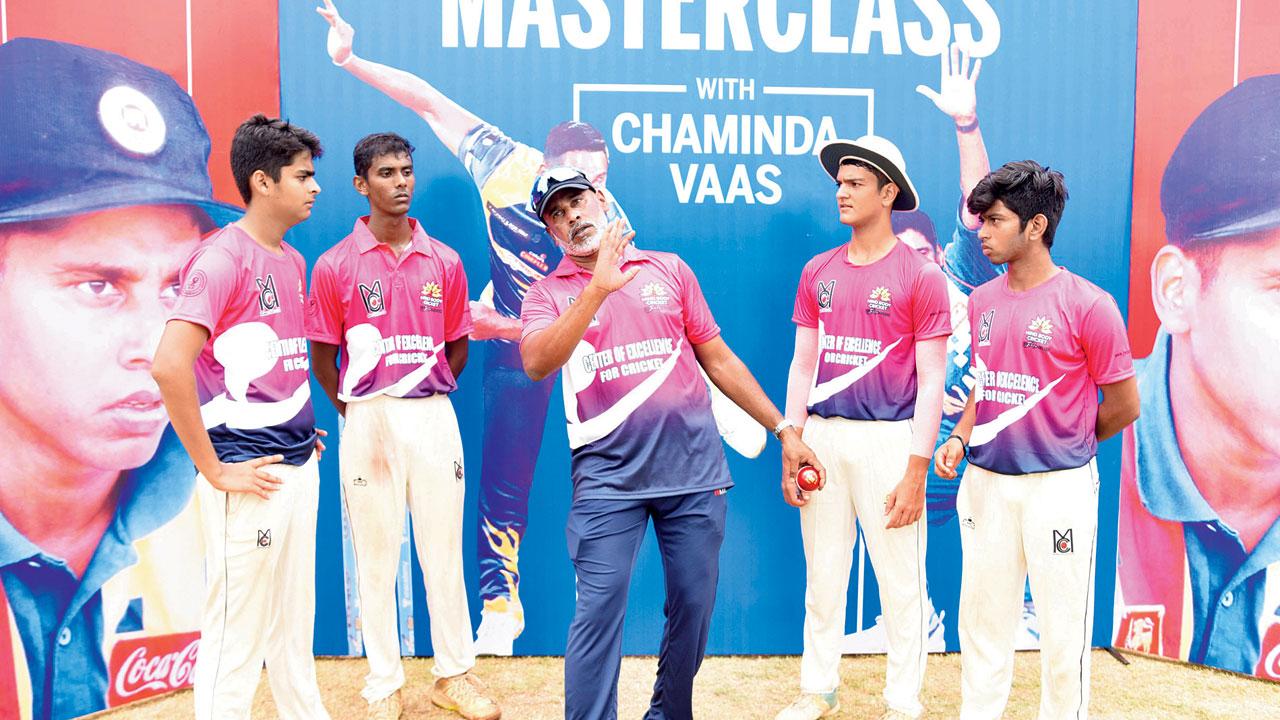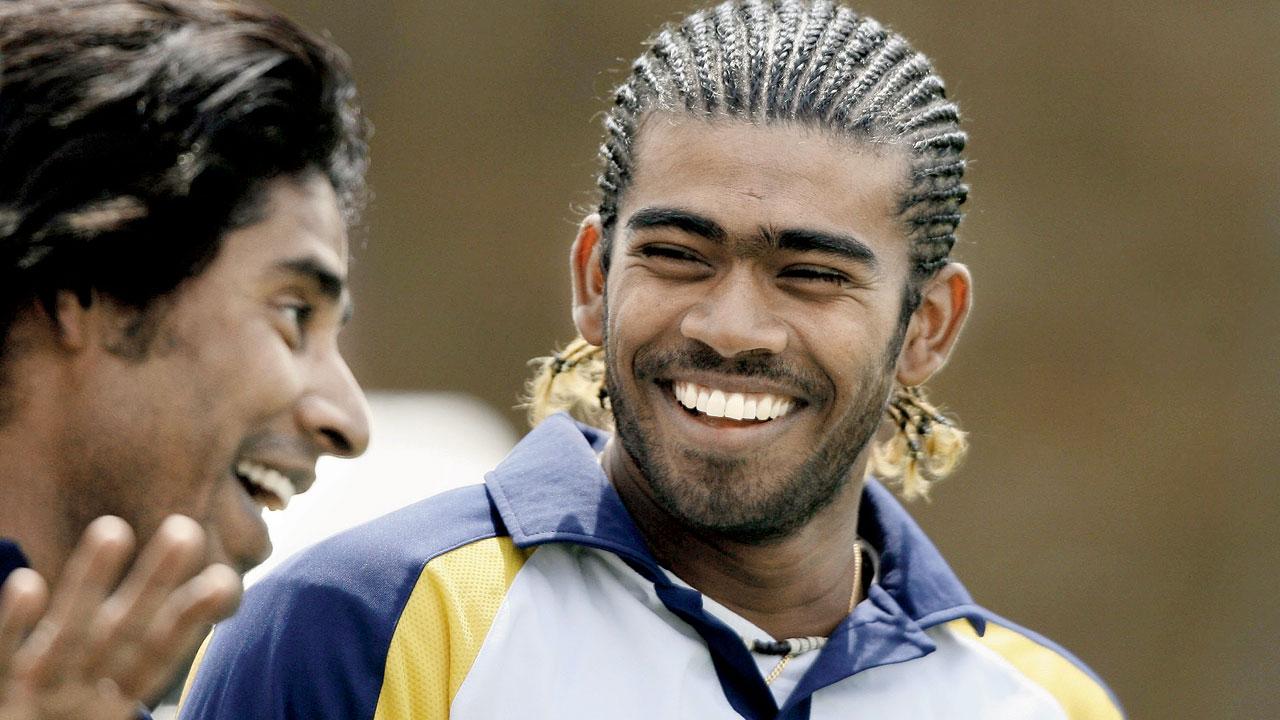Fast bowling great, Chaminda Vaas, who was a member of Sri Lanka’s 1996 World Cup-winning team, tells aspiring pace bowlers that they have to be clever in tackling the odds as theirs is a world full of batter-friendly pitches and thick bats
Sri Lanka’s fast bowling great Chaminda Vaas passes on vital tips to young fast bowlers during the Mid-day Masterclass session at the Air India ground in Kalina recently. Pics/Sameer Markande
 Sri Lanka’s legendary pace bowler Chaminda Vaas couldn’t have asked for a better time to be in India. While the mornings were spent coaching and mentoring aspiring fast bowlers, the evenings were about watching the recently-concluded Indian Premier League. Vaas, a veteran of 355 Test and 400 ODI wickets, was in Mumbai for a week-long coaching program organised by Mumbai Cricket Club and Jwala Singh’s Sports Foundation at the Air India Sports Club ground, Kalina, Santacruz.
Sri Lanka’s legendary pace bowler Chaminda Vaas couldn’t have asked for a better time to be in India. While the mornings were spent coaching and mentoring aspiring fast bowlers, the evenings were about watching the recently-concluded Indian Premier League. Vaas, a veteran of 355 Test and 400 ODI wickets, was in Mumbai for a week-long coaching program organised by Mumbai Cricket Club and Jwala Singh’s Sports Foundation at the Air India Sports Club ground, Kalina, Santacruz.
The former left-arm pacer, who was part of Sri Lanka’s 1996 World Cup-winning team, took time off for mid-day’s Masterclass, where budding pace bowlers got to learn the nuances of the game straight from the legend.
Edited excerpts from the interaction:
On Sri Lanka’s fast bowling evolution:
We have enough fast bowlers, but how we train them and how we take them into the future is a big question. First-class cricket has to be top-class and fitness has to be the number one [priority] for fast bowlers. We have enough talent to pursue [fast bowling] in Sri Lanka.

On his 400th ODI wicket—Yuvraj Singh:
As a cricketer when you play for the country, you never go for records. All I wanted is to do well for my team, for my country but the 400th wicket was special. The whole world knows who Yuvraj Singh is, he’s a great cricketer from India and I was really pleased to take his wicket for my 400th.
On India’s pace bowling evolution:
Over the years, India have produced so many good fast bowlers—Kapil Dev to Javagal Srinath, then Ishant Sharma and Jasprit Bumrah. India have produced so many good fast bowlers in the IPL too like Umran Malik. He has a lot of potential and it’s great to see him being picked for India. There are quite a few left-armers who have come up. Mohsin Khan, who played for Lucknow Super Giants, was very impressive. I think India are in safe hands when it comes to fast bowling. In the last two years, India have been doing really well in Tests, one-dayers and T20 cricket and there will be many more to emerge from the IPL.
On the toughest batsman he has bowled to:
There were so many tough batters—Sachin Tendulkar, Brian Lara, Adam Gilchrist, Matthew Hayden, Shahid Afridi. They all were great and not easy to bowl to. We had to bowl a perfect line to them and hope for them to make a mistake.

Chaminda Vaas interacts with young fast bowlers at Kalina
On the art of reverse swing:
It differs from person to person. For a left-arm pacer, the natural swing is in-swing. If you take a right-arm fast bowler, the natural swing is out-swing. So, you have to master your stock ball. If you do that, you will be able to get wickets and practise other stuff like slower balls and variations. As a fast bowler, you have to practise for many, many hours. If you develop those skills, you can be a great bowler.
On the ideal grip for out-swing:
For a left-arm fast bowler, the fingers will point towards fine leg and the wrist has to be very firm if you want to bowl an in-swinger to a right-handed batsman. The shiny side should be on the left. But, if you want to bowl out-swing, the shiny part has to be on the right side and your fingers should point towards first slip. When you deliver the ball, you have to show your palm to the batsman and finger towards slip. If you are able to roll the finger perfectly, then the ball does everything for you.

Chaminda Vaas displays a seam position
On the importance of head position:
To bowl quick, you have to have a nice rhythmical run-up, good technique, back foot landing, which can be sideways or front open. Then it depends how you gather the ball. Once you gather, it’s how you stride, release the ball and then follow through. Once you do everything in line, things will fall into place. Perfect examples are Dale Steyn, Brett Lee, Mitchell Starc. These are all 145-plus kmph bowlers. Their running technique, stride, follow through, how they release the ball, their head position—everything is in line. If your head is falling, that means your action is not complete.
On the importance of wrist position:
A fast bowler needs to have a nice wrist position to bowl good out-swing or in-swing. If you hit the seam properly, the bowler has the advantage with the ball moving away or coming in, according to the grip. The wrist position becomes vital—fingers behind and palm has to be shown to the batsman all the time. It shouldn’t be forgotten that the game has always been advantageous for batters. Even pitches are prepared for batters and bats nowadays are so different. So, bowlers have to be clever enough to tackle all these things and master their craft to do well.

Chaminda Vaas (left) with Lasith Malinga. Pic/Getty Images
On how Lasith Malinga trained:
Malinga used to bowl maybe 60 balls at a stretch till he was satisfied with the yorkers. Every fast bowler has skills, but you have to practise till you reach perfection. Even if you have finished bowling to the batters in the nets, you have to do spot bowling, get to your length, get your yorkers and slower balls going. That’s how you will get better.
On an ideal bowling action:
There is no ideal fast bowling action. Even scientists can’t say that side on or the open-chested one is the perfect action. Fast bowlers will get injured irrespective of your action. That is why fitness is key. There are fast bowlers with strong physiques, there are bowlers who are rhythmical. You have to find out which type of a fast bowler you are and train accordingly. There are so many strength-conditioning exercises.
When I started playing cricket, I had a mixed bowling action. Most people said that I won’t be able to play for the country for many years. But I took it as a challenge and proved that even though I have a mixed action, I can perform. The areas which I focused on were my front leg, my back. But being a fast bowler, you will never be 100 per cent fit. You’ll always have a niggle and you need to have courage to play with those niggles. Of the three departments—batting, bowling and fielding, fast bowling is the most difficult. Being a fast bowler, you need to have a big heart. Even in 35-40 degrees temperature, the captain will come and tell you to bowl for me. You can’t complain, you have to bowl. You need fitness, commitment and dedication. If you have all these things, you can become a great fast bowler.
Your advice to youngsters who want to master reverse swing:
Before reverse swing, young bowlers have to learn running techniques. We call fast bowlers athletes. If you don’t have good a running technique, you won’t be able to be a good fast bowler. So, the running technique and action are vital. If you talk about action—there’s the side-on action, front-on and mixed action. If you have a mixed action, you won’t be able to bowl quick and you’ll tend to get injured.
On the challenges with the red and white balls for different formats:
The red ball swings for many overs. If you shine the ball properly, you can swing the ball many times. But, when it comes to the white ball, it will swing for only first five to six overs. You need to have the right technique to swing the ball and the right technique to take wickets. There is not much difference between red and white balls, but if you know the art of fast bowling, it’s easy. Fast bowling is not rocket science.


